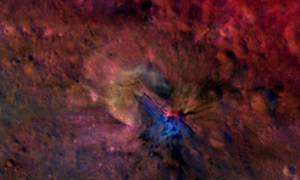Dec 19 2013
Some beauty is revealed only at a second glance. Such a case is the giant asteroid Vesta, which was the object of scrutiny by the Dawn spacecraft from 2011 to 2012. Scientists at the Max Planck Institute for Solar System Research in Katlenburg-Lindau have now re-analysed the images of this giant asteroid obtained by Dawn’s framing camera. The images reveal in unprecedented detail not only geological structures that are invisible to the naked eye, but also landscapes of incomparable beauty.
 Crater Aelia, 40°O/14°S: this colourful composite image from NASA's Dawn mission shows the flow of material inside and outside a crater called Aelia on the giant asteroid Vesta. The area is around 14 degrees south latitude. The images that went into this composite were obtained by Dawn's framing camera from September to October 2011. © NASA/JPL-Caltech/UCLA/MPS/DLR/IDA
Crater Aelia, 40°O/14°S: this colourful composite image from NASA's Dawn mission shows the flow of material inside and outside a crater called Aelia on the giant asteroid Vesta. The area is around 14 degrees south latitude. The images that went into this composite were obtained by Dawn's framing camera from September to October 2011. © NASA/JPL-Caltech/UCLA/MPS/DLR/IDA
When viewed with the human eye, protoplanet Vesta, which orbits in the asteroid belt between Mars and Jupiter, is quite unspectacular colour-wise: a grayish body pitted by a variety of large and small craters. New analyses however, now show Vesta, a relic from an early phase of planet formation, in a different light. Researchers at Max Planck can now see structures such as melts from impacts, craters buried by quakes and foreign material brought by space rocks, visible with a resolution of 200 feet (60 metres) per pixel.
“The key to these images is the seven colour filters of the camera system on board the spacecraft,” said Andreas Nathues, the framing camera team lead at Max Planck. Since different minerals reflect light of different wavelengths to different degrees, the filters help reveal compositional differences that remain hidden without them. In addition, scientists calibrated the data so that the finest variations in brightness can be seen.
In the new colourized images, different colours indicate different materials on the surface of Vesta. They reveal impressive formations and a wide range of geological diversity, said Nathues. But above all, the colour-coded images are impressive because of their beauty.
“No artist could paint something like that. Only nature can do this,” said Martin Hoffman, a member of the framing camera team also at Max Planck. Pictures of the crater Aelia, the crater Antonia and an area near the crater Sextilia show some of Vesta’s most impressive sites.